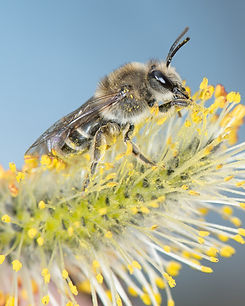
Family Halictidae > Genus Nomia
Nomia
Large Sweat Bees
In Minnesota, there are two described species within the genus Nomia. There is just one record of a Nomia nortoni male, but Nomia universitatis has been recorded in several southeastern counties in Minnesota. Bees in this genus nest in the ground and have either solitary or communal nests. Nomia are medium to large black bees with distinctive mother-of-pearl or neon bands tinged with blue or green highlights on their abdominal tergites (segments). Some bee observers call them "neon Nomia", a mnemonic to help remember to associate the distinctive abdominal bands with the genus. Bees in this genus have three forewing submarginal cells with the second cell is smaller than the first and third cells. Unlike other genera in the family Halictidae, Nomia do not have a strongly arched forewing basal vein.
Nomia females collect pollen on hairs on their hind leg tibiae and femora. Bees in this genus range in length from 7 to 20 mm (0.27 to 0.79 inches).

A Nomia nortoni female visiting Persicaria.

wing
position
on flowers

N0. species in MN
2
size range

Phenology

Genus Characteristics

Black bees with mother-of-pearl bands on the abdomen. Females collect pollen on the hind leg tibiae and femora.

Three forewing submarginal cells. The 2nd cell is smaller than the 1st and 3rd cell. Basal vein not strongly arched.
Nomia Species in Minnesota
Scientific Name | Lecty | Host |
|---|---|---|
Nomia nortoni | polylectic | |
Nomia universitatis | oligolectic | Psoralidium tenuiflorum (Arduser) |
Source: Minnesota Department of Natural Resources, Minnesota Bee Species List (August 2023).
https://files.dnr.state.mn.us/eco/mcbs/mn-statewide-bee-list.pdf
Explore More Halictidae Genera
Explore Bee Families

Apidae
15 genera, 133 species
Bumble bees Bombus
Longhorn bees
Epimelissodes, Eucera, Melissodes
Carpenter bees
Ceratina, Xylocopa
Honey bees Apis
Digger bees Anthophora
Cuckoo bees Brachymelecta, Epeolus, Holcopasites, Nomada, Neolarra, Triepeolus
Squash bees Xenoglossa

2 genera, 39 species
Halictidae
10 genera, 133 species
Metallic green sweat bees
Agapostemon, Augochlora, Augochlorella, Augochloropsis
Large sweat bees
Dieunomia, Nomia
Short-faced bees Dufourea
Sweat bees Halictus
Small sweat bees Lasioglossum
Cuckoo (blood) bees Sphecodes
Megachilidae
14 genera, 86 species
Resin and pebble bees Anthidiellum, Dianthidium, Heriades, Paranthidium
Carder bees Anthidium, Pseudoanthidium
Mock orange bees Chelostoma
Mason bees Osmia, Hoplitis
Leafcutter bees Megachile
Sharp-tailed cuckoo bees Coelioxys
Dark cuckoo bees Stelis

Citations and Further Reading
Droege, S., et al. (2024). The Very Handy Bee Manual: 2.0. How to Catch and Identify Bees and Manage a Collection.
Gibbs, J., Hanuschuk, E., Miller, R., Dubois, M., Martini, M., Robinson, S., ... & Onuferko, T. M. (2023). A checklist of the bees (Hymenoptera: Apoidea) of Manitoba, Canada. The Canadian Entomologist, 155, e3.
Mitchell, T. B. (1960). Bees of the eastern United States. Technical Bulletin No. 141. North Carolina Agricultural Experiment Station.
Portman, Z. M., Gardner, J., Lane, I. G., Gerjets, N., Petersen, J. D., Ascher, J. S., ... & Cariveau, D. P. (2023). A checklist of the bees (Hymenoptera: Apoidea) of Minnesota. Zootaxa, 5304(1), 1-95.
Ribble, D. W. (1962). A revision of the banded subgenera of Nomia in America (Hymenoptera: Halictidae) (Doctoral dissertation, University of Kansas, Entomology).
Wilson, J. S., & Messinger Carril, O. J. (2016). The bees in your backyard: a guide to North America's bees. Princeton University Press.
Page Photography Credits
Heather Holm
Ron Goetz CC BY-NC 4.0 (Nomia)
Angella Moorehouse Used with permission (Nomia)















